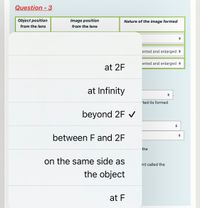Question

Transcribed Image Text:Question - 3
Object position
Image position
Nature of the image formed
from the lens
from the lens
erted and enlarged +
erted and enlarged +
at 2F
at Infinity
ted its formed
beyond 2F V
between F and 2F
the
on the same side as
int called the
the object
at F

Transcribed Image Text:Question - 3
Object position
Image position
Nature of the image formed
from the lens
from the lens
Before or beyond
beyond 2F
2F
Between F and
on the same side as the object +
virtual, inverted and enlarged +
optic center
At a distance F
at F
virtual, inverted and enlarged →
Expert Solution
This question has been solved!
Explore an expertly crafted, step-by-step solution for a thorough understanding of key concepts.
Step by stepSolved in 2 steps

Knowledge Booster
Similar questions
- Question in the imagearrow_forward7- want the solution steps for this answered questionarrow_forward2 people have the vision that becomes unclear at the same distance from their eyes one person has a near-point of 95cm and the other person has a far point of 95cm which of these people requires a stronger prescription? For normal vision a healthy near point is 25 cm and a healthy far point is infinity I need help figuring out the math to why the sighted person requires the stronger prescriptionarrow_forward
- 3 Projector Consider a projector mounted on the ceiling in a classroom. There is a small display - a video screen inside the projector unit. A lens is used to project an image onto the wall of the classroom. (a) Suppose the projector uses a converging lens with a focal length of 105 mm to create the image on the wall. If the display is located 108 mm from the lens, what must the distance between the wall and the lens be in order to focus the projected image? (b) If the display is 24 mm by 36 mm, what are the dimensions of its image on the wall? (c) Draw an accurate ray diagram of the slide, projector, and screen. Your diagram should clearly indicate the display, its image on the wall, the location of the lens, and the focal points of the lens.arrow_forward14 The side view mirror of a car is a spherical convex mirror with radius of curvature 95.9 m. If a truck is riding at distance 72 m behind the car, how far away does the truck appear to be (image distance), in m? Give your answer as a positive number.arrow_forward8 a) The diagram shows two light rays that form an intermediate image by the objective lens an optical compound microscope. These rays are incident on the eyepiece lens. The focal points of the two lenses are marked. not to eyepiece lens scale objective lens to Draw rays on the diagram to show the formation of the final image. b) The object is viewed when the microscope is in normal adjustment. State what is meant by normal adjustment when applied to a compound microscope. c) The object O is placed at a distance of 24.0 mm from the objective lens and the final image is formed at a distance 240 mm from the eyepiece lens. The focal length of the objective lens is 20.0 mm and that of the eyepiece lens is 60.0 mm. The near point of the observer is at a distance of 240 mm from the eyepiece lens. Calculate the distance between the lenses.arrow_forward
- MY NOTES ASK YOUR TEACHER PRACTICE ANOTHER A 1.0 cm-tall object stands in front of a converging lens. It is desired that a virtual image 2.0 times larger than the object be formed by the lens. How far from the lens (in cm) must the object be placed to accomplish this task, if the final image is located 10 cm from the lens? cm Need Help? Read Itarrow_forwardPart 3 - Keplerian Telescope A telescope magnifies far-off images. Rays hitting the objective are almost parallel and are focused to form an inverted, real image at the focal point of the eyepiece. The eyepiece refracts the light so the rays leave the eyepiece again almost parallel. The object remains inverted, and so the angular magnification is defined as M= -B/a, where the angles are shown in Figure 2. objective eyepiece f. f. f. F e F. h inverted image at infinity Figure 2: A Keplerian telescope, invented by Johannes Kepler in 1611, uses two converging lenses as shown. An objective with focal length fo and an eyepiece with focal length fe focus nearly parallel light rays from a distant object into an inverted image of much smaller size than the object. 1. Assume that a and ß are small angles (much less than 1 radian). Using the ray diagram shown in Figure 2 and considering two appropriate triangles, show that M = -fo/ fe.arrow_forward
arrow_back_ios
arrow_forward_ios